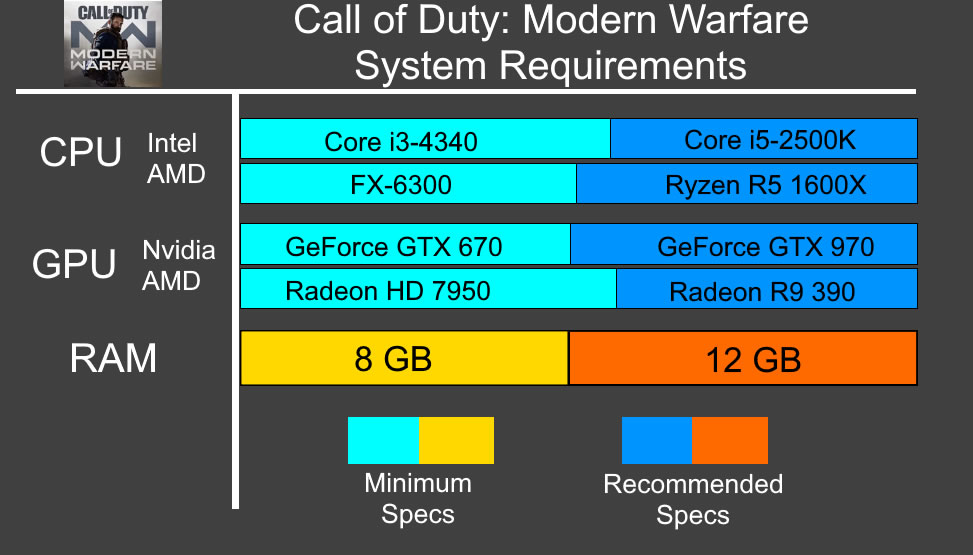AMD Radeon R9 290 vs Nvidia GeForce GTX 770: What is the difference?
37points
AMD Radeon R9 290
41points
Nvidia GeForce GTX 770
PowerColor OCSapphire Tri-XVTX3D X-EditionPowerColor PCS PlusSapphire Battlefield 4
Comparison winner
vs
54 facts in comparison
AMD Radeon R9 290
Nvidia GeForce GTX 770
Why is AMD Radeon R9 290 better than Nvidia GeForce GTX 770?
- 1.64 TFLOPS higher floating-point performance?
4.85 TFLOPSvs3.21 TFLOPS - 8.2 GPixel/s higher pixel rate?
41.7 GPixel/svs33.5 GPixel/s - 2GB more VRAM?
4GBvs2GB - 18 GTexels/s higher texture rate?
152 GTexels/svs134 GTexels/s - 64GB/s more memory bandwidth?
288GB/svs224GB/s - 256bit wider memory bus width?
512bitvs256bit - 1024 more shading units?
2560vs1536 - 2660million more transistors?
6200 millionvs3540 million
Why is Nvidia GeForce GTX 770 better than AMD Radeon R9 290?
- 384MHz faster GPU clock speed?
1046MHzvs662MHz - 20W lower TDP?
230Wvs250W - 628MHz faster memory clock speed?
1753MHzvs1125MHz - 2512MHz higher effective memory clock speed?
7012MHzvs4500MHz - 138MHz faster GPU turbo speed?
1085MHzvs947MHz - 12°C lower load GPU temperature?
82°Cvs94°C - Has Double Precision Floating Point (DPFP)?
- 10°C lower idle GPU temperature?
31°Cvs41°C
Which are the most popular comparisons?
AMD Radeon R9 290
vs
Nvidia GeForce GTX 1060
Nvidia GeForce GTX 770
vs
Nvidia GeForce GTX 1650
AMD Radeon R9 290
vs
AMD Radeon Vega 8
Nvidia GeForce GTX 770
vs
Nvidia GeForce RTX 3060
AMD Radeon R9 290
vs
AMD Radeon RX 550
Nvidia GeForce GTX 770
vs
Nvidia GeForce GTX 1050
AMD Radeon R9 290
vs
AMD Radeon RX 580
Nvidia GeForce GTX 770
vs
Nvidia GeForce GTX 750 Ti
AMD Radeon R9 290
vs
AMD Radeon R9 290X
Nvidia GeForce GTX 770
vs
Nvidia GeForce RTX 3050 Laptop
AMD Radeon R9 290
vs
Nvidia GeForce GTX 960
Nvidia GeForce GTX 770
vs
Nvidia GeForce GTX 760
AMD Radeon R9 290
vs
AMD Radeon RX 570
Nvidia GeForce GTX 770
vs
Nvidia GeForce MX250
AMD Radeon R9 290
vs
Nvidia GeForce GTX 1050
Nvidia GeForce GTX 770
vs
Nvidia GeForce MX330
AMD Radeon R9 290
vs
Nvidia GeForce GTX 970
Nvidia GeForce GTX 770
vs
Nvidia GeForce GTX 960
AMD Radeon R9 290
vs
AMD Radeon RX 470
Nvidia GeForce GTX 770
vs
Nvidia GeForce MX150
Price comparison
User reviews
Overall Rating
AMD Radeon R9 290
1 User reviews
AMD Radeon R9 290
10. 0/10
1 User reviews
Nvidia GeForce GTX 770
0 User reviews
Nvidia GeForce GTX 770
0.0/10
0 User reviews
Features
Value for money
10.0/10
1 votes
No reviews yet
Gaming
8.0/10
1 votes
No reviews yet
Performance
10.0/10
1 votes
No reviews yet
Quiet operation
10.0/10
1 votes
No reviews yet
Reliability
10.0/10
1 votes
No reviews yet
Performance
GPU clock speed
662MHz
1046MHz
The graphics processing unit (GPU) has a higher clock speed.
GPU turbo
947MHz
1085MHz
When the GPU is running below its limitations, it can boost to a higher clock speed in order to give increased performance.
pixel rate
41.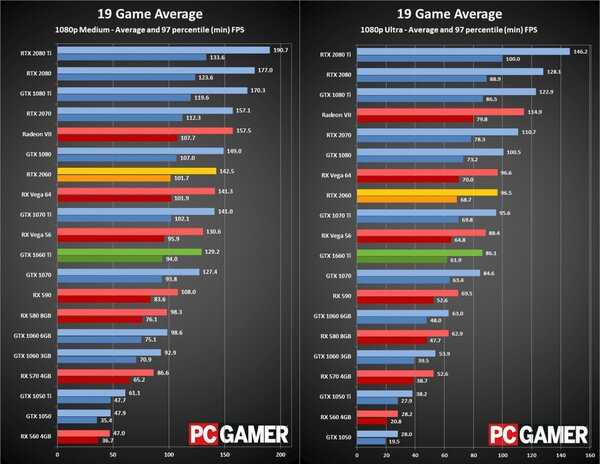 7 GPixel/s
7 GPixel/s
33.5 GPixel/s
The number of pixels that can be rendered to the screen every second.
floating-point performance
4.85 TFLOPS
3.21 TFLOPS
Floating-point performance is a measurement of the raw processing power of the GPU.
texture rate
152 GTexels/s
134 GTexels/s
The number of textured pixels that can be rendered to the screen every second.
GPU memory speed
1125MHz
1753MHz
The memory clock speed is one aspect that determines the memory bandwidth.
shading units
Shading units (or stream processors) are small processors within the graphics card that are responsible for processing different aspects of the image.
texture mapping units (TMUs)
TMUs take textures and map them to the geometry of a 3D scene. More TMUs will typically mean that texture information is processed faster.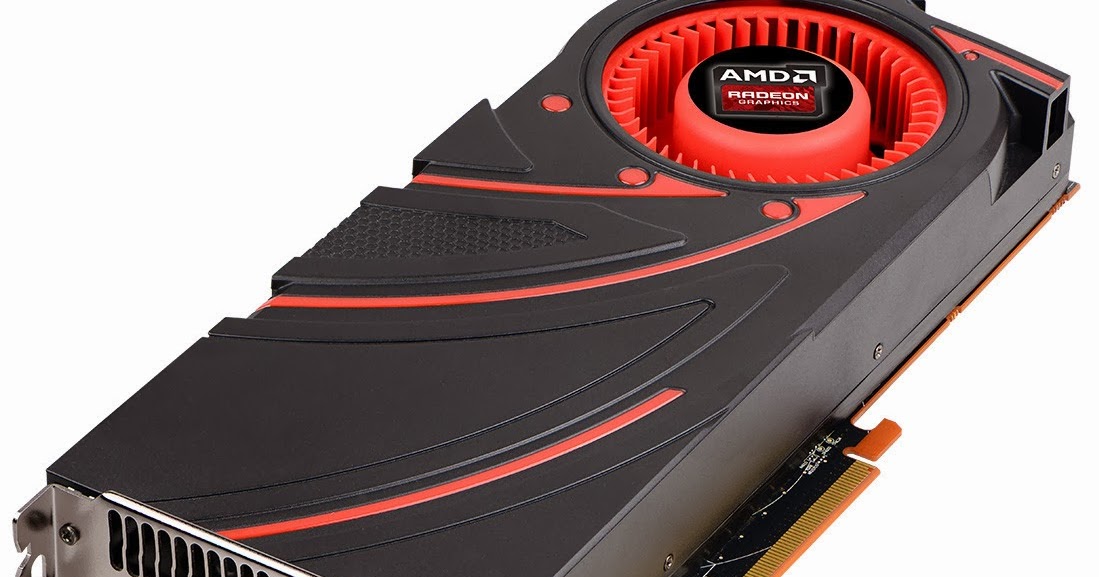
render output units (ROPs)
The ROPs are responsible for some of the final steps of the rendering process, writing the final pixel data to memory and carrying out other tasks such as anti-aliasing to improve the look of graphics.
Memory
effective memory speed
4500MHz
7012MHz
The effective memory clock speed is calculated from the size and data rate of the memory. Higher clock speeds can give increased performance in games and other apps.
maximum memory bandwidth
288GB/s
224GB/s
This is the maximum rate that data can be read from or stored into memory.
VRAM (video RAM) is the dedicated memory of a graphics card. More VRAM generally allows you to run games at higher settings, especially for things like texture resolution.
GDDR version
Newer versions of GDDR memory offer improvements such as higher transfer rates that give increased performance.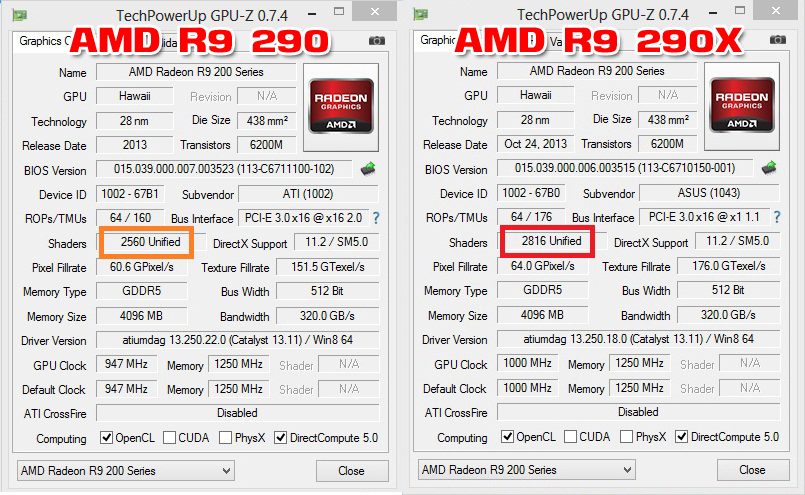
memory bus width
512bit
256bit
A wider bus width means that it can carry more data per cycle. It is an important factor of memory performance, and therefore the general performance of the graphics card.
Supports ECC memory
✖AMD Radeon R9 290
✖Nvidia GeForce GTX 770
Error-correcting code memory can detect and correct data corruption. It is used when is it essential to avoid corruption, such as scientific computing or when running a server.
Features
DirectX version
DirectX is used in games, with newer versions supporting better graphics.
OpenGL version
OpenGL is used in games, with newer versions supporting better graphics.
OpenCL version
Some apps use OpenCL to apply the power of the graphics processing unit (GPU) for non-graphical computing. Newer versions introduce more functionality and better performance.
Supports multi-display technology
✔AMD Radeon R9 290
✔Nvidia GeForce GTX 770
The graphics card supports multi-display technology. This allows you to configure multiple monitors in order to create a more immersive gaming experience, such as having a wider field of view.
load GPU temperature
A lower load temperature means that the card produces less heat and its cooling system performs better.
supports ray tracing
✖AMD Radeon R9 290
✖Nvidia GeForce GTX 770
Ray tracing is an advanced light rendering technique that provides more realistic lighting, shadows, and reflections in games.
Supports 3D
✔AMD Radeon R9 290
✔Nvidia GeForce GTX 770
Allows you to view in 3D (if you have a 3D display and glasses).
supports DLSS
✖AMD Radeon R9 290
✖Nvidia GeForce GTX 770
DLSS (Deep Learning Super Sampling) is an upscaling technology powered by AI.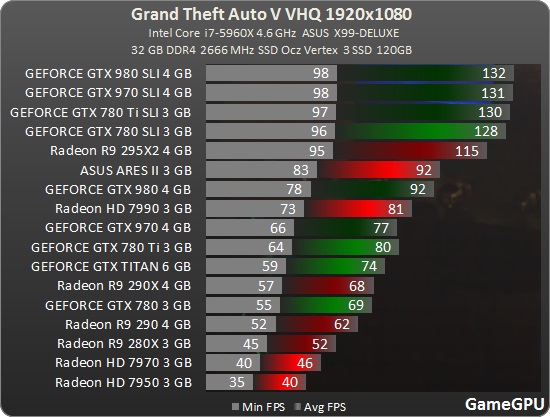 It allows the graphics card to render games at a lower resolution and upscale them to a higher resolution with near-native visual quality and increased performance. DLSS is only available on select games.
It allows the graphics card to render games at a lower resolution and upscale them to a higher resolution with near-native visual quality and increased performance. DLSS is only available on select games.
PassMark (G3D) result
This benchmark measures the graphics performance of a video card. Source: PassMark.
Ports
has an HDMI output
✔AMD Radeon R9 290
✔Nvidia GeForce GTX 770
Devices with a HDMI or mini HDMI port can transfer high definition video and audio to a display.
HDMI ports
More HDMI ports mean that you can simultaneously connect numerous devices, such as video game consoles and set-top boxes.
HDMI version
Unknown. Help us by suggesting a value. (AMD Radeon R9 290)
Unknown. Help us by suggesting a value. (Nvidia GeForce GTX 770)
Newer versions of HDMI support higher bandwidth, which allows for higher resolutions and frame rates.
DisplayPort outputs
Allows you to connect to a display using DisplayPort.
DVI outputs
Allows you to connect to a display using DVI.
mini DisplayPort outputs
Allows you to connect to a display using mini-DisplayPort.
Price comparison
Which are the best graphics cards?
Page not found — Technical City
Page not found — Technical City
We couldn’t find such page: /en/video/radeon-r9-290-vs-geforce-gtx-770%23characteristics
Popular graphics cards comparisons
GeForce RTX
3060 Ti
vs
GeForce RTX
3060
GeForce RTX
2060 Super
vs
GeForce RTX
3060
GeForce RTX
3060 Ti
vs
GeForce RTX
3070
GeForce GTX
1060 6 GB
vs
Radeon RX
580
GeForce GTX
1050 Ti
vs
GeForce GTX
1650
GeForce GTX
1660 Ti
vs
GeForce GTX
1660 Super
Popular graphics cards
GeForce RTX
4090
GeForce GTX
1660 Super
GeForce RTX
3060 Ti
GeForce RTX
3060
GeForce GTX
1050 Ti
GeForce RTX
3070
Popular CPU comparisons
Ryzen 5
5600X
vs
Core i5
12400F
Ryzen 5
3600
vs
Core i5
10400F
Core i5
10400F
vs
Core i3
12100F
Ryzen 5
3600
vs
Ryzen 5
5600X
Ryzen 5
5600X
vs
Ryzen 5
5600G
Ryzen 5
3600
vs
Core i3
12100F
Popular CPUs
Ryzen 5
5500U
Ryzen 5
5600X
Core i5
12400F
Core i3
1115G4
Core i3
12100F
EPYC
7h22
NVIDIA GeForce GTX 770 vs AMD Radeon R9 290X comparison which is better?
| General information | |
|
Price-quality ratio The sum of all the advantages of the device divided by its price. |
|
| 34.9%
11.4% (48.5%) better than |
23.5% |
|
Architecture |
|
| Kepler | GCN 2.0 |
|
Codename |
|
| GK104 | Hawaii |
|
Type |
|
| Desktop | Desktop |
|
Release price |
|
| $399
-150 $ (-27.3%) better than |
549 $ |
|
Number of shaders |
|
| 1536 | 2816
1280 (83.3%) better than |
|
Core clock |
|
| 1046MHz | n/a |
|
Boost frequency |
|
| 1085MHz
At 138 MHz (14.6%) better than |
947 MHz |
|
Number of transistors |
|
3.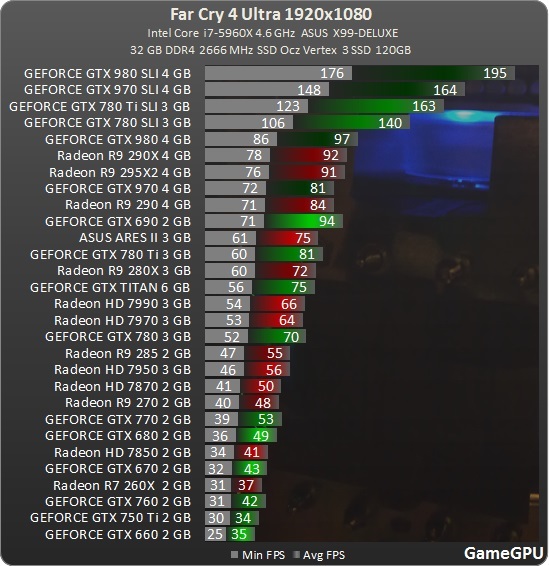 540 million 540 million |
6.200 million |
|
Process |
|
| 28 nm | 28 nm |
|
Interface |
|
| PCIe 3.0 x16 | PCIe 3.0 x16 |
|
Power Demand (TDP) Calculated thermal power shows the average heat dissipation in load operation, |
|
| 230 W
-20 W (-8%) better than |
250W |
|
Length |
|
| 26.7 cm | 275 mm |
|
Additional power connectors |
|
| 1x 8-pin and 1x 6-pin | 1 x 6-pin + 1 x 8-pin |
|
G-SYNC Ready NVIDIA G-SYNC technology delivers a smooth gaming experience with variable refresh rates and the elimination of visual artifacts. |
|
|
3D Vision |
|
| + | n/a |
|
GPU Boost |
|
| + | n/a |
|
Vulkan NVIDIA’s Vulkan technology allows developers to gain low-level access to the GPU to optimize graphics commands (better than OpenGL and Direct3D APIs). |
|
| n/a | + |
|
CUDA The CUDA architecture enables applications that are optimized for |
|
|
Maximum temperature |
|
| 98 °C | n/a |
|
Multi-monitor support |
|
| 4 | n/a |
|
Decred / DCR (Decred) |
|
| n/a | 1.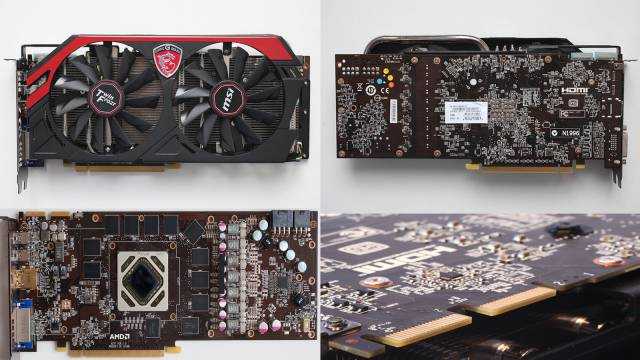 07 Gh/s 07 Gh/s |
|
Zcash / ZEC (Equihash) |
|
| n/a | 1 Sol/s |
|
Bus |
|
| PCI Express 3.0 | PCIe 3.0 |
|
Number of CUDA cores A large number of CUDA cores improve performance in graphics computing, |
|
| 1536 | n/a |
|
Height |
|
| 11.1 cm | n/a |
|
HDCP |
|
| + | n/a |
|
Maximum resolution via VGA |
|
| 2048×1536 | n/a |
|
Audio input for HDMI |
|
| internal | n/a |
|
Design |
|
| n/a | reference |
|
Eyefinity |
|
| n/a | + |
|
HDMI |
|
|
DisplayPort support |
|
|
AppAcceleration |
|
| n/a | + |
|
FreeSync |
|
| n/a | + |
|
HD3D |
|
| n/a | + |
|
LiquidVR |
|
| n/a | + |
|
TressFX |
|
| n/a | + |
|
TrueAudio |
|
| n/a | + |
|
Audio DDMA |
|
| n/a | + |
|
UVD |
|
| n/a | + |
|
Blu Ray 3D |
|
| + | n/a |
|
3D Gaming |
|
| + | n/a |
|
3D Vision Live |
|
| + | n/a |
|
FXAA |
|
|
TXAA |
|
|
Adaptive VSync |
|
| + | n/a |
|
Minimum power supply |
|
| 600W | n/a |
|
PhysX |
|
| + | n/a |
|
Video Connectors |
|
| 1x Dual Link DVI-I, 1x Dual Link DVI-D, 1x HDMI, 1x DisplayPort | 2x DVI, 1x HDMI, 1x DisplayPort |
|
DirectX |
|
| 12 (11_0) | DirectX® 12 |
|
Floating point performance |
|
3. 333 gflops 333 gflops |
5.632 gflops |
|
Ethereum / ETH (DaggerHashimoto) |
|
| 3.9 Mh/s | 25.75 Mh/s |
|
CrossFire |
|
| n/a | + |
| Memory | |
|
Memory type |
|
| GDDR5 | GDDR5 |
|
Maximum memory Large video memory allows you to run demanding games with lots of textures, |
|
| 2 GB | 4 GB
2 GB (100%) better than |
|
Memory bus width The wider the video memory bus, the more data is transferred to the GPU per unit of time and the better performance in demanding games. |
|
| 256 bit | 512 bit
256 bit (100%) better than |
|
Shared memory |
|
| n/a | — |
|
Memory frequency A high memory frequency has a positive effect on the speed of a video card with a large amount of data. |
|
| 7012 MHz
At 5762 MHz (461%) better than |
1250 MHz |
|
Memory bandwidth The higher the data transfer bandwidth, the more effective RAM the PC can use. |
|
| 224.3 | 320
95.7 (42.7%) better than |
Aftermarket Mid-Range Fight R9 290X vs GTX 770
This content has been written by a website visitor and has been rewarded.
Secondary market mid-range battle R9 290X vs GTX 770
It so happened that in the secondary market these two video cards are in the same price category, at least in Krasnoyarsk, the cost of video cards in the secondary market (Krasnoyarsk the first week of September 2014) :
-GTX 770 can be bought from 9000r to 15000r, it all depends on the version and amount of memory, although I have seen 4Gb versions sold for the minimum cost.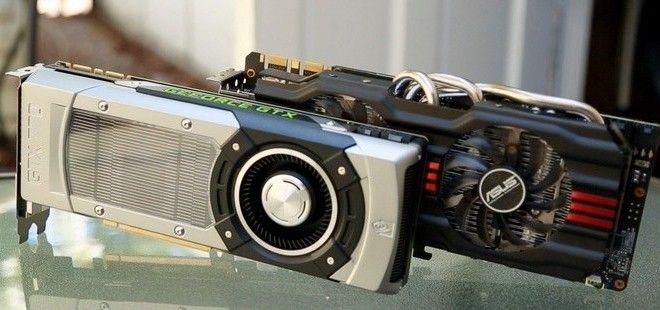 It’s a pity, of course, that his older friend GTX 780 still costs from 16000r, he would have looked much more interesting in this short review.
It’s a pity, of course, that his older friend GTX 780 still costs from 16000r, he would have looked much more interesting in this short review.
-R9 290X can be purchased from 11000r to 17000, and in turn R9 290 can be bought from 10000r.
Of course, the opponents are not equal in class, but since it so happened that their cost on the secondary is very close, we will look at how much the difference is in the performance of these video cards.
To begin with, a table with technical characteristics:
A few photos and a brief description of the cards:
Cards with reference COs will participate today:
MSI GTX 770
ASUS R9 290X
Card connectors are identical: DVI x2, HDMI, DisplayPort
Both need two 8pin + 6pin cables for power connection
The map from the red camp is slightly heavier and one centimeter longer:
MSI GTX 770
ASUS R9 290X
I want to tell you about a number of important features of each of the accelerators, these features can become key when choosing a card:
The GTX 770 has a fairly low power consumption compared to its opponent.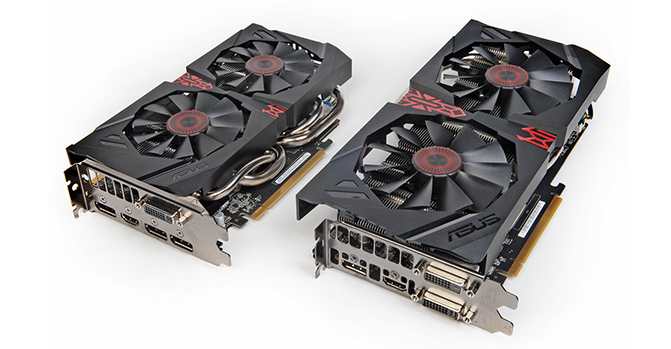 Plus, the map is quite cold, again when compared with the enemy. The reference turbine is much quieter at idle than the opponent’s turbine. An alternative CO for the GTX 770 is much easier to find, but despite these rather significant pluses? GTX 770 green is much less productive.
Plus, the map is quite cold, again when compared with the enemy. The reference turbine is much quieter at idle than the opponent’s turbine. An alternative CO for the GTX 770 is much easier to find, but despite these rather significant pluses? GTX 770 green is much less productive.
* An important advantage of the GTX 770 is that the configuration of two video cards is not so demanding on the power supply and a good 750-850 watt PSU with a silver certificate or higher is enough, in other words, a pair of GTX 770 consumes a little more energy than one R9290X, and in terms of performance it will be much faster.
R9 290X card with a high level of performance, but consumes a lot of energy and is very hot, an important drawback is a noisy reference turbine, but finding an alternative CO is not a problem. The main thing is to find something to cool the video card power subsystem. I will say right away that there are excellent Arctic Cooling Accelero Xtreme IV / III on the market that will perfectly replace the noisier 290X turbine and they have radiators for the power subsystem in the kit.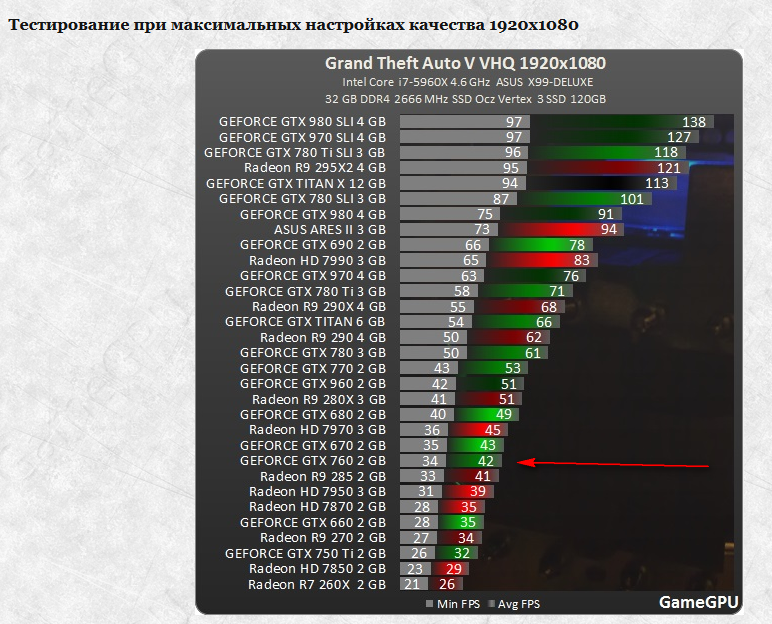
Test Stand and Test Method:
Test Stand:
• HPZR30w 30″ QHD Monitor
— Processor: Intel Core i7-4790K (Scalped, OS 4.7 Ghz 1.256v 4/8 HT-ON)
— Motherboard: ASUS Maximus VI GENE Z87 (BIOS 1505)
-RAM: Corsair Dominator GT 4x4Gb 2200MHz 9-11-10-27 1T
— Power supply: Corsair AX760 (ACTIV FAN OFF, HIBRYD)
— Video cards: R9 290X GTX 770
-Disk system: SSD OCZ VTX3-25SAT3-60G
— Reobas: Bitfenix RECON
— Thermal interface: Arctic Cooling MX-4
Software:
Software tested:
• 3DMark06
• 3DMark FS
Heaven DX11 Benchmark 3.0
• Metro Last Light Redux Benchmark
• LostPlanet2 Benchmark DX11
Overclocking:
• ASUS.GPU.Tweak
Monitoring:
• RealTemp 3.70
• Gpu-z 0.7.8
HWMonitor x64
Drivers:
• nvidia forceware 340.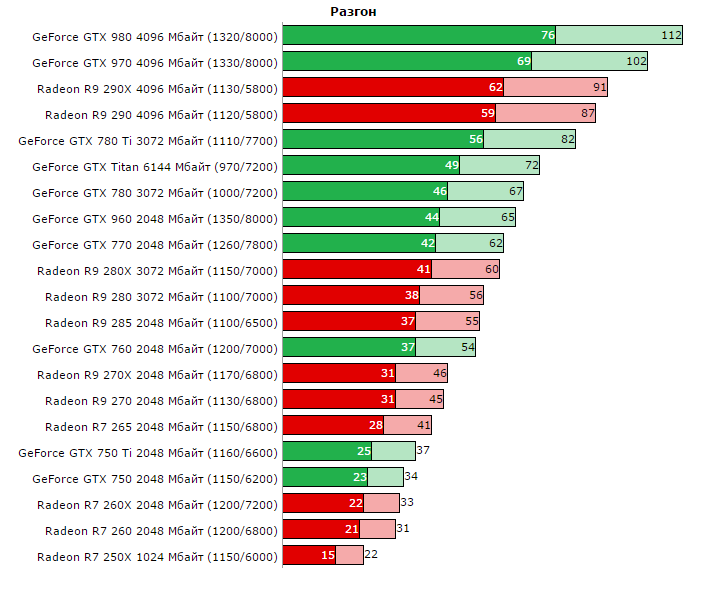 52
52
• catalyst 14.4
Video card overclocking:
MSI GTX 770 Managed to overclock with a reference turbine to frequencies of 1215/7550 MHz
ASUS R9 290X unfortunately with standard cooling was not possible, since the temperature of this instance with default frequencies was at a high level of 96 degrees.
Card load temperature:
Video card noise level, idle-load with turbine operation:
Testing:
3DMark06
Video cards are on a par here, and you won’t see much difference here, since there is nothing to load 290X, although the leadership remains behind it.
3DMark FS
At a resolution of 1920×1080, video cards were tested at standard settings, and at a resolution of 2560×1600, the test was run at Extreme settings.
In this benchmark, the result is quite indicative, the victory for 290X.
Heaven DX11 Benchmark 3.0
Test leader 290X.
Metro Last Light Redux Benchmark, FPS
The settings were turned to the maximum quality value, only the resolution changed:
Both video cards at 1920×1080 will show good performance in this game, but in order to play at 2560×1600 with both representatives, you will have to lower the graphics quality.
LostPlanet2 Benchmark DX11, FPS
The settings were turned to the maximum quality value, only the resolution changed:
In this old benchmark, the difference between the video cards is almost invisible, although with an increase in resolution the speed dropped by 30 FPS
Conclusion:
In general, testing has come to an end and, of course, the one-headed champion from the red team has become the obvious leader in terms of performance.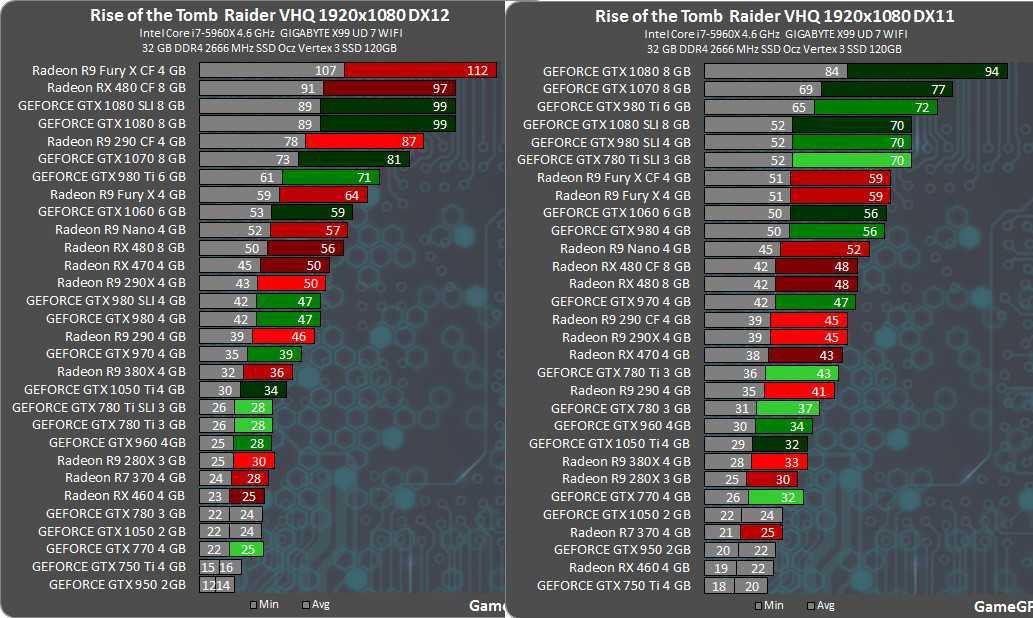 gluttonous and very hot, but for the money (11000-13000) that it is sold on the secondary market, this can be forgiven. R9290X is great for working in QHD resolution.
gluttonous and very hot, but for the money (11000-13000) that it is sold on the secondary market, this can be forgiven. R9290X is great for working in QHD resolution.
The defeat of the GTX 770 is, of course, due to the lower class of the video card, and it cannot be said that it lost, because for an equal fight there should have been a GTX 780, but it is already in a higher price category of the secondary market. The advantages of the GTX 770 include lower temperatures and power supply requirements, plus the GTX 770 usually has a good overclocking potential, I had three of them and all the cards overclocked quite well, the GTX 770 is perfect for working in FHD resolution, for comfortable work QHD will need a pair of GTX 770s.
Unfortunately, there was no time for more tests, simply speaking, one of the cards was bought out urgently, sorry, so many R9 290X were left without results, I barely persuaded the buyer to pass the Metro Last Light Redux Benchmark, without it it would be a shame post a review, as soon as I have a 290X again I will finish testing and maybe add the results of two GTX 770.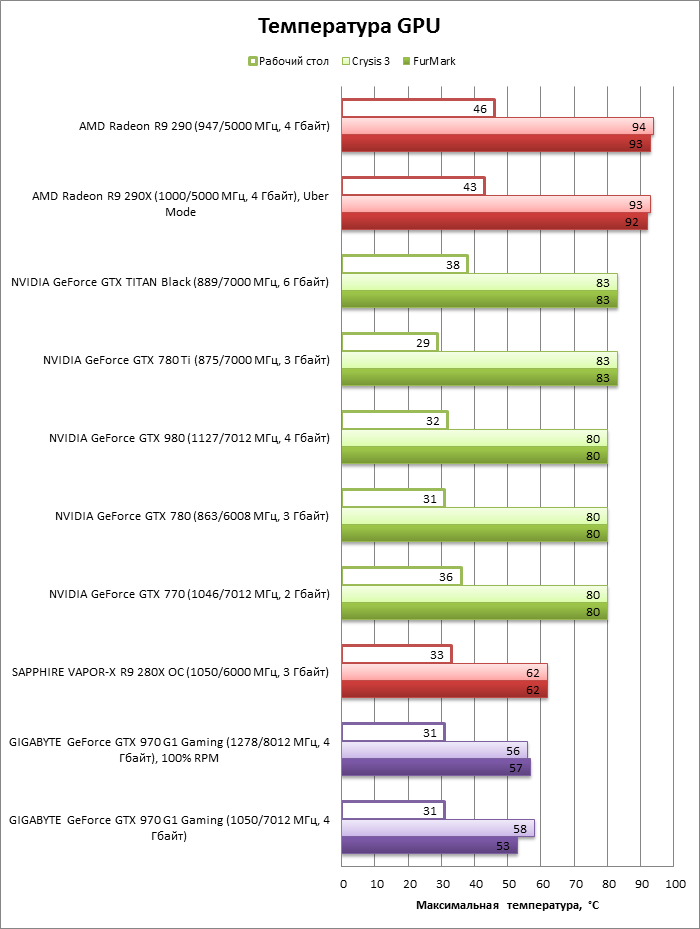

 The more%, the better the quality per unit price in comparison with all analogues.
The more%, the better the quality per unit price in comparison with all analogues. 